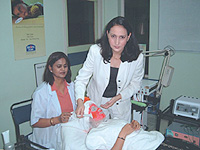| Glycolic acid peeling is the latest ‘Fruit acid’ facial rejuvenation system available in India. Glycolic acids have been used over the past two decades in west, but recently popularized in India for dermatological and cosmetic surgery practices. This treatment gives an overall improvement in the skin texture, skin tone, pigmentation, control of Acne and reduction in facial fine lines and wrinkles, hence giving a younger and healthier look to the face. It is also used in Photo aging conditions like Melasma, Xerosis and
Rosacea.
Glycolic acid is a natural constituent of Sugar cane, and the smallest molecule of AHA family i.e. Alpha hydroxy acids. It is optimally absorbed into all types of the skin. A large variety of cosmetics have them as ingredients for many commercial and home care beauty products. They also have antioxidant properties that help reverse and slow down the aging process.
| There are many different peel systems available today. It is important to understand how different compositions differ. The chemical effects of Glycolic acid are based on its
bioavailability, which is the concentration and the pH of the free acid used in the solution. The acid peel solutions come in four strengths of 20%, 35%, 50%, 70%, with pH value of 1.6 to 0.6. It means only a fraction of the Glycolic acid is available as Free acid in the solution, which means limited bioavailability of the Glycolic acid to the skin, hence no strong acidic reaction is seen. |
 |
It is interesting to know that this peel procedure can be done on any skin type, colour, male or female, any age group, teens or older.
The procedure lasts for 2-5 minutes only with excellent results. It not only clears the superficial skin imperfections by desquamation but also improves skin renewal process.
Peel procedure can be performed on the face, forehead, neck, chest, back, waist and any of the extremities. Each site will tolerate different concentration and contact time. The subsequent peels are to be repeated at an interval of 2 to 3 weeks. However, if patient is eager and skin favorable, the intervals can be shortened. The peel procedure has to be done either by a doctor or a trained aesthetician.
It requires first a thorough cleansing of the site, the free acid application (a fixed quantity only) and retention for 2-5 minutes on the site, depending upon the underlying problem, skin type, condition and tolerance. A patch test is always recommended in sensitive skins.
Acid is then immediately neutralised by an appropriate bicarbonate spray followed by cold compression. An emollient cream, which is free of alpha hydroxyacids and retenoids is then applied on the site. Home care requires a regular use of moisturizer or sunscreens. There are certain minor precautions to be kept in mind before, during and after the procedure, which are described to the patient at the time of screening only.
With the advent of new technologies we are thus not only saving precious time but also are able to control and check certain skin imperfections and ailments, which were otherwise difficult to achieve with conventional cosmetic treatments.
—The author is managing director of Personal Point and an acclaimed fitness expert
|